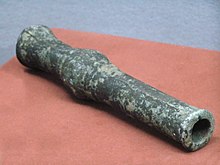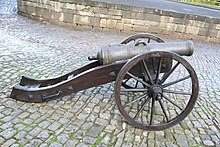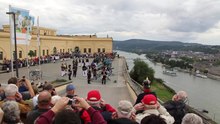gun
Gun (originally the weapon the shooter , so bow ; historical piece or box ) designated in military affairs a serious and suitable for use in the hand tube weapon . Colloquially, cannon is also used synonymously for all guns, but this only describes one type of gun.
The land-based large guns are grouped together in the artillery category; smaller ones are used by the infantry . The development of guns was very much dependent on general technical developments, be it the invention of gunpowder , the developments in metallurgy and, in particular, casting technology , motorization, etc .; Range, firepower and accuracy have been increased continuously.
For a long time, nothing was known about internal ballistics (the processes involved in firing a projectile from a firearm from the time the shot was released until the projectile emerged from the barrel). Instead, the best combination of bullet type, powder type and powder quantity was determined in shooting tests for a particular weapon .
Forerunner of the guns
In ancient times, guns were mechanical throwing machines like the catapult , ballista and onager . In the Middle Ages, the heaviest of the mechanical throwing machines was invented, the trebuchet , which continued to be used after the introduction of firearms. Today the term “gun” only includes firearms. Mechanical precursors, also known as throwing guns , are not considered guns.
history
precursor
Mechanical guns, the catapults , were in use from the 4th century BC. Chr. In use. Archimedes invented in the 3rd century BC A type of cannon that built up high pressure through water vapor and could fire projectiles with a metal tube ( steam cannon ).
First firearms
The invention of gunpowder in China before the 10th century made the construction of firearms possible . Black powder was first used for incendiary weapons such as fire lances , grenades and rockets . The Song Chinese may have first used bamboo canes to detonate black powder in what was known as a fire lance and which had not yet fired projectiles. In the Yuan period , metal pipes with a diameter of up to 2.6 cm were detectable for the first time in order to fire various non-precisely fitting projectiles, in particular arrows, iron and steel splinters and poisonous substances, with black powder. A slender, bronze hand tube, 34 cm long, weighing over 7 pounds, with an ignition hole, straight bore and reinforced ignition chamber was excavated in Manchuria ; it dates from 1288 and is considered the oldest document in China. At this time, the use of more precise iron darts apparently also appeared; such projectiles are still preserved. Numerous Chinese technicians served in the Mongol armies , who used firearms on their campaigns.
13th to 15th centuries

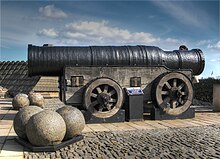

In Europe itself, firearms first appeared during the turn of the 13th and 14th centuries. The concept of the gunpowder fueled arrows came to Europe via the open trade routes of Arabia in the form of the Madfaa . The first references in the sources to the use of firearms are uncertain. The use of primitive cannons in the defense of Forlì in Italy is mentioned in 1284 , other references refer to Brabant in 1311 and to the siege of the fortress of Metz in 1324. The first depiction of a fire pot is from Walter de Milemete around 1326. They were bulbous Pots that lay on table-like frames and shot heavy arrows. They are also reliably documented in Italy in 1326 in documents of the Republic of Florence ( "pilas seu palloctas ferreas et canones de metallo" - ie iron projectiles or bullets and cannons made of metal), later in southern Germany. A short time later, firearms were found practically all over Europe, so that one can speak of an initial arms race here .
The Europeans were the first to replace iron arrows with heavy spherical projectiles (lead or stone balls ), which led to the next development of the bombarde or stone rifle . Soon they also experimented with cast-iron balls, but they were much more expensive to manufacture and also required more black powder; the stone cans were no match for that. These disadvantages ensured that the stone balls were still used in some cases well into the 16th century ( see also the reforms in the gun system of Emperor Maximilian I in the article Kartaunen ). It was soon recognized that the acceleration of a projectile with a barrel increased the range and accuracy.
The early forms of the guns were first used in sieges . The siege guns can be divided into four types: main rifles , emergency rifles , quarter rifles and mortars . The latter was a high-speed cannon that also used exploding ammunition for the first time and that was used for sieges or as part of the fortress artillery (as a fortress gun ). An intermediate stage between the mortar and the cannon was the howitzer , which was invented in Bohemia - today's Czech Republic . Since the early guns had a short effective range, they were placed close to the walls. The muzzle was protected from enemy fire by a hinged board screen that was pulled open before the powder was ignited. As early as 1400, during the siege war, European armies had the most powerful guns at their disposal, some of which were preserved giant guns such as the Pumhart von Steyr or the Mons Meg . The range of these early guns was rather short, usually no more than 180 m.
At the time of the Hussite Wars (1419–1439) the first field guns were developed. Together with the (horse-drawn) mount , these guns were mobile for the first time.
Ship guns were also used on ships for the first time . For example, the Santa Maria , the flagship of Christopher Columbus , had four rotating guns caliber 9 cm on board. The armament of expedition ships and the range and accuracy of ship guns became an important factor in the expedition that was now beginning (see Age of Discovery , Driving Force and Requirements for Discovery Voyages ).
The new profession of piece foundry emerged from that of bell foundry ; both used similar manufacturing techniques. By the last third of the 14th century, European guns had become the most advanced and powerful in the world. In particular, the Hundred Years War (1337–1453) between France and England provided a surge in innovation. Among the Hussites alone, the number of firearms used increased tenfold in ten years; so in 1428 they brought about 3,000 small arms , 300 howitzers and 60 large guns into the field. In 1415, Henry V used ten guns to shoot down the walls of Harfleur . Since 1450, guns were common in large armies, including in the army of Charles the Bold of Burgundy, who was still a knight . In 1453 the previously impregnable double wall with a moat around Constantinople was shot down by the Turks ready for storm. The guns used for this had been made by a European Christian. The superior European guns also played a key role in the expansion of Europe .
The first late medieval gun barrels were designed as bar ring guns made of wrought iron bars held together with iron rings . Later tubes were made of iron , copper , bronze or brass and were cast in one piece, which gave the gun greater strength. Chamber guns have a two-part barrel.
Bronze and iron dominated the cast gun. However, iron cannons were repeatedly damaged when fired because of their brittle material properties. Often the closure piece tore and screw caps warped, after which the closure had to cool for hours.
16th to 18th century


In the 16th century, siege guns were developed into main rifles , slaughters , cartoons and basilisks . From 1550 this was simplified to double cartons, cartons and half cartons and switched to the caliber system . In the middle of the 16th century the double cartoons were the heaviest siege guns. At this time, the usage of the bullet changed to become a gun designation; for example, cartons became "40 pounds" and half cartons became "24 pounds". Light breech- loaders were preferred to be mounted on ships in rotating tanks . But the breech loaders were soon abandoned because of their lack of gas tightness.
Bronze became popular with all field guns because of its stability and its good casting properties . Iron guns also weighed considerably more with the same caliber. In addition, the composition of the iron (especially its high phosphorus content , its low sulfur content ( smelting of iron )) played a significant role in the strength of a cannon, so that certain regions within Europe, although identical knowledge was also available elsewhere, prevailed for production . At the same time, there was a real competition for cannon founders who additionally preferred certain locations ( e.g. Asslar and Marsberg in Germany, Sussex and Kent in England). However, ship and fortress guns only had to be moved a little, so that the cheaper iron was still preferred for them. Some giant artillery pieces (for example the tsar cannon from 1586) were commissioned more for reasons of prestige than for military necessities and were therefore show weapons.
During the Thirty Years' War, the Swedes in particular experimented with increasingly lighter guns that were very mobile and were assigned to field units (regiments). These regimental pieces initially consisted of thin copper or iron pipe, which was wrapped with ropes, sheet metal strips, hemp and linen and reinforced with a thick leather coat. They could be moved by one or two men, but had insufficient shooting performance and were subject to high wear and tear. They were therefore only in use until the Polish War of 1628/29. Nevertheless, they achieved lasting fame as " leather cannons ". The demands on the mobility of the cannons then led to them becoming lighter and lighter in general. In April 1629 the royal foundry Stockholm succeeded in producing the first three-pounder, which was very agile at 123 kg. A little later the weight was even reduced to just 116 kg. The name regiment pieces for this new field artillery was retained.
There should be no significant changes to the guns over the next 200 years. There were only minor improvements such as leveling screws, which made the time-consuming manual elevation adjustment with wedges and levers unnecessary and made the aiming process more precise. The height did not have to be readjusted after each shot. Another improvement in the early 18th century was the introduction of flintlocks for ignition. This eliminates the need to keep a burning fuse on hand, even with cannons. The construction of smaller guns for the infantry, the so-called amusettes, began .
At the beginning of the 18th century, however, the production technology changed . The guns were solid cast and the barrel was later drilled out with vertical drilling machines.
19th to 21st century
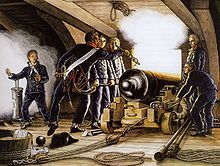



In the middle of the 19th century there were far-reaching innovations as a result of the industrial revolution: guns with rifled barrel could fire explosive long projectiles that were set in rotation by the trains , which significantly improved accuracy. This enabled the range to be increased beyond the core range for the first time . In 1840 the Swedish industrialist Martin von Wahrendorff succeeded in developing a rear loading system for (still smooth) cannons ready for series production. This breech- loading cannon system was soon introduced in Prussia . In 1846 Wahrendorff had a system for drawn tubes followed. Up until this point, the guns had rigid, closed-back tubes. The breech loader locks , on the other hand, required precise and robust moving mechanical parts.
The invention of the railway also led to the first railway guns . The guns were also increasingly mounted on pivot mounts, which led to better directivity of the guns and absorbed the recoil , especially at sea .
When the production of high quality steel became much cheaper in the middle of the 19th century , this extremely stable material was used for the mass production of guns. These first cast steel cannons included the Alfred Krupps breech loading cannons, which triggered a true “revolution” in terms of weapons technology and were initially used primarily by Prussia .
Repeated attempts to increase the rate of fire led to the development of small-caliber repeater guns , but brought hardly any practical success. At the end of the 19th century, France put the Canon de 75 mle, the first real rapid-fire gun, into service in 1897 . The main feature was the long return pipe . The gun barrel was not rigidly connected to the mount, so that the recoil caused the barrel to run back in the mount after the shot and was absorbed by a hydropneumatic braking device. The gun did not roll backwards after the shot and remained aimed at the target. This feature was able to significantly increase the rate of fire and has been used on all large-caliber guns ever since.
At the beginning of the 20th century, after the invention of the low-smoke powder based on cellulose nitrate, black powder was replaced as a propellant. Due to the lower burn rate, the projectile could be accelerated longer in long gun barrels.
During the First World War , the mortar was developed as an infantry companion weapon into a muzzle-loading high-speed gun, which was light in relation to its caliber and had a short range. Towards the end of World War were machine guns developed which the rate of fire of the machine guns combined and the target effect of the guns. They were first used as anti-aircraft guns .
After the development of the motor vehicle, guns were first pulled by trucks and later mounted on tanks or self-propelled guns in a very mobile manner and in some cases armored . The Blitzkrieg strategy of World War II required this improvement in mobility. Large siege guns, such as railway guns and large fortress guns, lost their military value due to the growing importance of the air force . As aircraft carriers became more important than battleships , the era of large ship guns came to an end.
The invention of the recoilless gun gave the infantry a light field gun. After the Second World War, missile weapons often took on the role of guns, making anti-tank guns, for example, superfluous.
In the Cold War and guns were to fire nuclear build grenades. In the USA, among other things, the 280 mm nuclear cannon, which was also known as the M65 "Atomic Annie" , was developed, and later also guns for conventional and nuclear ammunition such as the M109 self-propelled howitzer . In the case of main battle tanks , smooth- barreled cannons and arrow ammunition again prevailed in order to achieve higher muzzle velocities.
Since then, no major innovations have been made in gun technology. Alternative drive concepts to gunpowder (with an explosive gas mixture for gas guns , with electromagnetism for railgun and coilgun ), mainly for maritime applications, have so far not got beyond the experimental stage.
Systematics
Guns can be distinguished in their functional principle and their structure and the type of loading activity.
function
Structure, components
- Smooth barrel cannon
- Cannon with rifled barrel
- Mount
- Earth spur
- Gun barrel
- Cane cradle
- Pipe haulers
- Wedge lock
- Screw lock
Type of loading activity
use
- Field gun
- Infantry gun
- Anti-tank gun
- Anti-aircraft gun
- Siege gun
- Fortress gun
- Coastal gun
- Ship gun
- Mountain gun
Records

The cannons with the longest range and largest caliber were almost all railway guns :
- The Paris gun , which was able to fire from the German front near Laon to Paris during World War I (approx. 120 km).
- The K 12 in World War II had 196 caliber lengths, a caliber of 211 mm and a range of 115 km. However, the gun was not very useful; it was more about breaking the record.
- The greatest weight was 1350 tons (identical guns Gustav and Dora in World War II)
- The largest armor-piercing projectile fired (the Gustav and Dora guns in World War II) was 6.79 m long and weighed 7100 kg
- The largest caliber was 914 mm for the American " Little David " mortar
- The currently largest front loading cannon in the world is on the island of Malta in the former British Fort Rinella . The gun there is a 100 ton RML 17.72 inch gun .
Use outside of combat
- During a state visit or the birth of an heir to the throne, gun salutes are fired with mostly historical cannons.
- Historically: used as a midday cannon
- As background music for the 1812 overture
- As a jump start for satellites ( High Altitude Research Project )
- The endangered mountain slope is shot at with a cannon to intentionally trigger avalanches
See also
- Cannon V3 , also called HDP (high pressure pump) or "Millipede", the official cover name was "Busy Lieschen"
- The wooden cannon is a primitive form of the cannon.
Individual evidence
- ^ Gun , entry in Meyers Großes Konversations-Lexikon, 1905 (accessed October 5, 2009)
- ^ Guns , entry in Brockhaus Bilder-Conversations-Lexikon, 1837 (accessed on October 5, 2009)
- ↑ Wurfgeschütz (demarcation), Mark Feuerle: Blide - Mange - Trebuchet: Technology, Development and Effect of the Wurfgeschütz in the Middle Ages , ISBN 978-3-928186-78-0
- ↑ Kelly DeVries, Robert Douglas Smith: Medieval military technology , University of Toronto Press, 2012, ISBN 978-1-4426-0497-1 , p. 117
- ↑ Georg W. Oesterdiekhoff: "The Development Of Mankind From Childhood To Adult Maturity", Springer VS , 2012, ISBN 978-3-531-19726-5 , p. 298 [1]
- ↑ Kelly DeVries, Robert Douglas Smith: Medieval military technology , University of Toronto Press, 2012, ISBN 978-1-4426-0497-1 , p. 137
- ↑ Kenneth Warren Chase: A Global History to 1700 , Cambridge University Press , 2003, ISBN 978-0-521-82274-9 , p. 32 [2]
- ↑ Volker Schmidtchen: “Giant Guns of the 15th Century. Technical top performances of their time ”, in: Technikgeschichte, Vol. 44, No. 2 (1977), pp. 153-173
- ↑ Volker Schmidtchen: “Giant Guns of the 15th Century. Technical top performances of their time ”, in: Technikgeschichte, Vol. 44, No. 3 (1977), pp. 213-237
- ↑ Kelly DeVries, Robert Douglas Smith: Medieval military technology , University of Toronto Press, 2012, ISBN 978-1-4426-0497-1 , p. 150
- ^ Carlo M. Cipolla: Sails and cannons - The European expansion at sea , Berlin: Verlag Klaus Wagenbach, 1990. ISBN 3-8031-3602-4
- ↑ 1648 War and Peace in Europe , edited by Klaus Bußmann and Heinz Schilling; Exhibition catalog, Münster / Osnabrück October 24, 1998 to January 17, 1999; P. 115
- ^ Johann Samuel Publication : General Encyclopedia of Sciences and Arts , Verlag J. f. Gleditsch, 1856, page 132 [3]
- ^ Dennis Angelo Castillo: The Maltese Cross: A Strategic History of Malta , Greenwood Publishing Group, 2006, ISBN 978-0-313-32329-4 , p. 134 [4]
literature
- WY Carman: A History of Firearms. From Earliest Times to 1914 . Courier Dover Publications, 2004, ISBN 978-0-486-43390-5
- Carlo M. Cipolla : Sails and Cannons. European expansion at sea . Verlag Klaus Wagenbach, Berlin 1999, ISBN 3-8031-3602-4 .
- Karl-Heinz Ludwig, Volker Schmidtchen : Metals and Power. 1000 to 1600. (= Propylaea history of technology, Volume 2, edited by Wolfgang König). Propylaen Ullstein, Berlin / Frankfurt am Main 1992, ISBN 3-549-05227-8 .
- Wolfgang König , Wolfhard Weber : Networks, steel and electricity. 1840 to 1914 (= Propylaea History of Technology, Volume 4, edited by Wolfgang König). Propylaen Ullstein, Berlin / Frankfurt am Main 1990, ISBN 3-549-05229-4 .
- Uta Lindgren : European technology in the Middle Ages 800–1400. Tradition and innovation. Gebr. Mann, Berlin 1998, ISBN 3-7861-1748-9 .
- Akoš Paulinyi , Ulrich Troitzsch : Mechanization and machinization. 1600 to 1840. (= Propylaea history of technology, Volume 3, edited by Wolfgang König). Propylaen Ullstein, Berlin / Frankfurt am Main 1991, ISBN 3-549-05228-6 .
- Bernhard Rathgen: The gun in the Middle Ages. Source-critical investigations . VDI-Verlag, Berlin 1928 ( digitized version )
- Christian Rohr : Compass, paper and gunpowder. (PDF) Lecture as part of the 2nd interdisciplinary lecture series of the Salzburg Medieval Studies Orient and Occident in the Middle Ages - Contacts and Conflicts . Salzburg, January 20, 2003. Archived from the original on February 11, 2014 ; accessed on January 2, 2016 .
- Eugène Viollet-le-Duc: Engins , in: Dictionnaire raisonné de l'architecture française du XIe au XVIe siècle . Tome 5. B. Bance, Paris 1861 ( French full text at Wikisource ) - from p. 218, section Engins de Guerre on early guns and mounts

